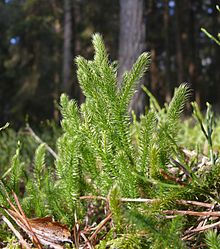
Lycopodiopsida is a class of vascular plants also known as lycopods or lycophytes. Members of the class are also called clubmosses, firmosses, spikemosses and quillworts. They have dichotomously branching stems bearing simple leaves called microphylls and reproduce by means of spores borne in sporangia on the sides of the stems at the bases of the leaves. Although living species are small, during the Carboniferous, extinct tree-like forms (Lepidodendrales) formed huge forests that dominated the landscape and contributed to coal deposits.

Huperzia is a genus of lycophyte plants, sometimes known as the firmosses or fir clubmosses; the Flora of North America calls them gemma fir-mosses. This genus was originally included in the related genus Lycopodium, from which it differs in having undifferentiated sporangial leaves, and the sporangia not formed into apical cones. The common name firmoss, used for some of the north temperate species, refers to their superficial resemblance to branches of fir (Abies), a conifer. As of 2020, two very different circumscriptions of the genus were in use. In the Pteridophyte Phylogeny Group classification of 2016, Huperzia is one of three genera in the subfamily Huperzioideae of the family Lycopodiaceae. Most species in the subfamily are placed in the genus Phlegmariurus. Huperzia is left with about 25 species, although not all have been formally transferred to other genera. Other sources recognize only Huperzia, which then has about 340 species.
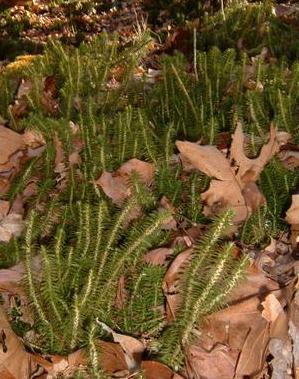
Huperzioideae is a subfamily of lycopsids in the family Lycopodiaceae. It has sometimes been recognized as a separate family, Huperziaceae. The Pteridophyte Phylogeny Group classification of 2016 recognizes three extant genera:

The Lycopodiaceae are an old family of vascular plants, including all of the core clubmosses and firmosses, comprising 16 accepted genera and about 400 known species. This family originated about 380 million years ago in the early Devonian, though the diversity within the family has been much more recent. "Wolf foot" is another common name for this family due to the resemblance of either the roots or branch tips to a wolf's paw.
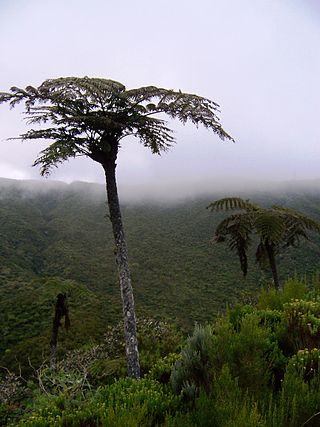
The Cyatheaceae are a family of ferns, the scaly tree ferns, one of eight families in the order Cyatheales in the Pteridophyte Phylogeny Group classification of 2016. Alternatively, the family may defined much more broadly as the only family in the Cyatheales, with the PPG I family treated as the subfamily Cyatheoideae. The narrower circumscription is used in this article.

Diphasiastrum is a genus of clubmosses in the plant family Lycopodiaceae. In the Pteridophyte Phylogeny Group classification of 2016, it is placed in the subfamily Lycopodioideae. It is closely related to the genus Lycopodium, and some botanists treat it within a broad view of that genus as a section, Lycopodium sect. Complanata. Some species superficially resemble diminutive gymnosperms and have been given common names such as ground-pine or ground-cedar.

Lycopodiella is a genus in the clubmoss family Lycopodiaceae. The genus members are commonly called bog clubmosses, describing their wetland habitat. The genus has a cosmopolitan distribution, with centers of diversity in the tropical New World and New Guinea. In the past, the genus was often incorporated within the related genus Lycopodium, but was segregated in 1964. In the Pteridophyte Phylogeny Group classification of 2016, Lycopodiella is placed in the subfamily Lycopodielloideae, along with three other genera. In this circumscription, the genus has about 15 species. Other sources use a wider circumscription, in which the genus is equivalent to the Lycopodielloideae of PPG I, in which case about 40 species and hybrids are accepted.

Dendrolycopodium dendroideum, synonym Lycopodium dendroideum, known as tree groundpine, is a North American species of clubmoss. It is part of a complex of species colloquially known as groundpine, which taxa were formerly lumped into the species Lycopodium obscurum. The species is native to Russia and also to the colder parts of North America. The genus Dendrolycopodium is accepted in the Pteridophyte Phylogeny Group classification of 2016, but not in other classifications, which submerge the genus in Lycopodium.

The genus Dendrolycopodium is a clubmoss genus in the family Lycopodiaceae. In the Pteridophyte Phylogeny Group classification of 2016, it is placed in the subfamily Lycopodioideae. Some sources do not recognize the genus, sinking it into Lycopodium. It is treated as section Obscura when retained within Lycopodium. The genus includes a discrete group of plants with similar morphologies. All have erect to semi-erect, branched stems.
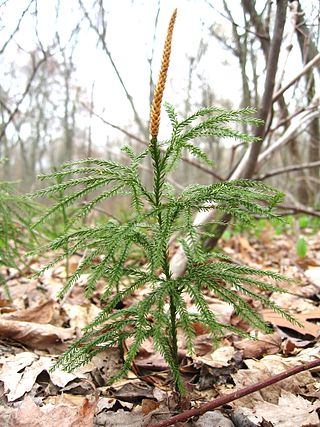
Dendrolycopodium obscurum, synonym Lycopodium obscurum, commonly called rare clubmoss, ground pine, or princess pine, is a North American species of clubmoss in the family Lycopodiaceae. It is a close relative of other species such as D. dendroideum and D. hickeyi, also treelike. It is native to the eastern United States and southeastern Canada from Georgia to Minnesota to Nova Scotia. It grows in the understory of temperate coniferous and deciduous forests, where it is involved in seral secondary succession, growing in clonal colonies some years after disturbance has occurred. It has also been found in Japan, Taiwan, Korea, Russian Far East, and northeastern China.

Diphasium scariosum, synonym Lycopodium scariosum, commonly known as spreading clubmoss or creeping club moss, is a species in the club moss family Lycopodiaceae. The genus Diphasium is accepted in the Pteridophyte Phylogeny Group classification of 2016, but not in other classifications which submerge the genus in Lycopodium. D. scariosum is native to Australia, New Zealand, and Borneo.

Spinulum is a genus of club mosses in the family Lycopodiaceae. In the Pteridophyte Phylogeny Group classification of 2016, it is placed in the subfamily Lycopodioideae. Some sources do not recognize the genus, sinking it into Lycopodium. Spinulum annotinum is widespread in the temperate Northern Hemisphere.

Austrolycopodium is a genus of lycophytes in the family Lycopodiaceae. In the Pteridophyte Phylogeny Group classification of 2016, it is placed in the subfamily Lycopodioideae. Some sources do not recognize the genus, sinking it into Lycopodium. Austrolycopodium species are mostly native to the temperate southern hemisphere.

Diphasium is a genus of lycophytes in the family Lycopodiaceae. In the Pteridophyte Phylogeny Group classification of 2016, it is placed in the subfamily Lycopodioideae. Some sources do not recognize the genus, sinking it into Lycopodium, others include it in Diphasiastrum. Diphasium species are mostly native to the temperate southern hemisphere, but extend northwards into Central America and the Caribbean.
Lycopodiastrum is a genus of lycophyte in the family Lycopodiaceae with only one species, Lycopodiastrum casuarinoides. In the Pteridophyte Phylogeny Group classification of 2016, the genus is placed in the subfamily Lycopodioideae. Some sources do not recognize the genus, sinking it into Lycopodium. Lycopodiastrum casuarinoides is native to south-eastern Asia, from Tibet through China to Japan in the north, and from Sumatra to Sulawesi in the south.
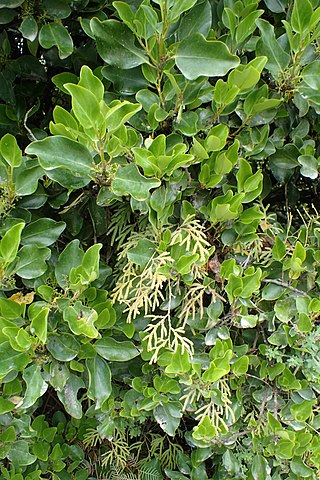
Pseudodiphasium is a genus of lycophyte in the family Lycopodiaceae with only one species, Pseudodiphasium volubile. In the Pteridophyte Phylogeny Group classification of 2016, the genus is placed in the subfamily Lycopodioideae. Some sources do not recognize the genus, sinking it into Lycopodium. Pseudodiphasium volubile is native from Peninsular Malaysia to Queensland, Australia, and has been introduced into Ecuador.
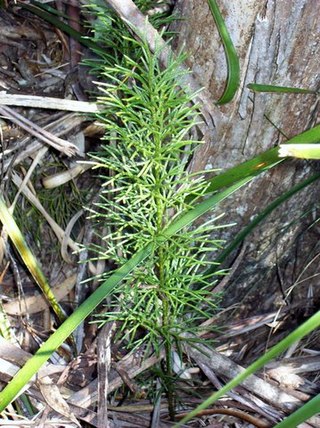
Pseudolycopodium is a genus of lycophyte in the family Lycopodiaceae with only one species, Pseudolycopodium densum, known as the bushy clubmoss. In the Pteridophyte Phylogeny Group classification of 2016, the genus is placed in the subfamily Lycopodioideae. Some sources do not recognize the genus, sinking it into Lycopodium. Pseudolycopodium densum is native to Australia, the North Island of New Zealand and New Caledonia. It is a spore-bearing vascular plant and grows up to a metre high. It is found in a wide variety of situations, often in high rainfall areas on sandy soils.

Lycopodioideae is a subfamily in the family Lycopodiaceae in the Pteridophyte Phylogeny Group classification of 2016. It is equivalent to a broad circumscription of the genus Lycopodium in other classifications. Like all lycophytes, members of the Lycopodioideae reproduce by spores. The oldest fossils of modern members of the subfamily date to the Early Cretaceous.

Lycopodielloideae is a subfamily in the family Lycopodiaceae in the Pteridophyte Phylogeny Group classification of 2016. It is equivalent to a broad circumscription of the genus Lycopodiella in other classifications. Like all lycophytes, members of the Lycopodielloideae are vascular plants that reproduce by spores.

Hemionitis is a genus of ferns in the subfamily Cheilanthoideae of the family Pteridaceae. Its circumscription varies greatly in different systems of fern classification. In the Pteridophyte Phylogeny Group classification of 2016, it was one of more than 20 genera in the subfamily Cheilanthoideae, and was said to have five species. Other sources treat it as the only genus in the subfamily, and so accept about 450 species. With the restricted circumscription, species are native to tropical America.
